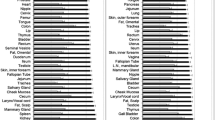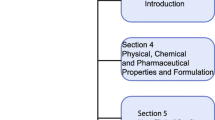Abstract
Purpose
ABY-029, a synthetic Affibody peptide, Z03115-Cys, labeled with a near-infrared fluorophore, IRDye® 800CW, targeting epidermal growth factor receptor (EGFR) has been produced under good manufacturing practices for a US Food and Drug Administration-approved first-in-use human study during surgical resection of glioma, as well as other tumors. Here, the pharmacology, phototoxicity, receptor activity, and biodistribution studies of ABY-029 were completed in rats, prior to the intended human use.
Procedures
Male and female Sprague Dawley rats were administered a single intravenous dose of varying concentrations (0, 245, 2449, and 24,490 μg/kg corresponding to 10×, 100×, and 1000× an equivalent human microdose level) of ABY-029 and observed for up to 14 days. Histopathological assessment of organs and tissues, clinical chemistry, and hematology were performed. In addition, pharmacokinetic clearance and biodistribution of ABY-029 were studied in subgroups of the animals. Phototoxicity and ABY-029 binding to human and rat EGFR were assessed in cell culture and on immobilized receptors, respectively.
Results
Histopathological assessment and hematological and clinical chemistry analysis demonstrated that single-dose ABY-029 produced no pathological evidence of toxicity at any dose level. No phototoxicity was observed in EGFR-positive and EGFR-negative glioma cell lines. Binding strength and pharmacokinetics of the anti-EGFR Affibody molecules were retained after labeling with the dye.
Conclusion
Based on the successful safety profile of ABY-029, the 1000× human microdose 24.5 mg/kg was identified as the no observed adverse effect level following intravenous administration. Conserved binding strength and no observed light toxicity also demonstrated ABY-029 safety for human use.



Similar content being viewed by others
References
DSouza AV, Lin H, Elliott JT et al (2016) Review of fluorescence guidance systems: identification of key performance capabilities beyond indocyanine green imaging. JBO 21:080901
Vahrmeijer AL, Frangioni JV (2011) Seeing the invisible during surgery. Br J Surg 98:749
Stummer W, Stepp H, Möller G et al (1998) Technical principles for protoporphyrin-IX-fluorescence guided microsurgical resection of malignant glioma tissue. Acta Neurochir 140:995–1000
Stummer W, Tonn J-C, Goetz C et al (2014) 5-Aminolevulinic acid-derived tumor fluorescence: the diagnostic accuracy of visible fluorescence qualities as corroborated by spectrometry and histology and postoperative imaging. Neurosurgery 74:310–320
Roberts DW, Valdés PA, Harris BT et al (2011) Coregistered fluorescence-enhanced tumor resection of malignant glioma: relationships between δ-aminolevulinic acid–induced protoporphyrin IX fluorescence, magnetic resonance imaging enhancement, and neuropathological parameters. J Neurosurg 114:595
Roberts DW, Valdés PA, Harris BT et al (2012) Glioblastoma multiforme treatment with clinical trials for surgical resection (aminolevulinic acid). Neurosurg Clin N Am 23:371–377
Valdés PA, Kim A, Brantsch M et al (2011) δ-Aminolevulinic acid–induced protoporphyrin IX concentration correlates with histopathologic markers of malignancy in human gliomas: the need for quantitative fluorescence-guided resection to identify regions of increasing malignancy. Neuro-Oncology 13:846–856
Stummer W, Pichlmeier U, Meinel T et al (2006) Fluorescence-guided surgery with 5-aminolevulinic acid for resection of malignant glioma: a randomised controlled multicentre phase III trial. Lancet Oncol 7:392–401
Stummer W, Reulen H-J, Meinel T et al (2008) Extent of resection and survival in glioblastoma multiforme: identification of and adjustment for bias. Neurosurgery 62:564–576
Ekstrand AJ, James CD, Cavenee WK et al (1991) Genes for epidermal growth factor receptor, transforming growth factor α, and epidermal growth factor and their expression in human gliomas in vivo. Cancer Res 51:2164–2172
Zimmermann M, Zouhair A, Azria D, Ozsahin M (2006) The epidermal growth factor receptor (EGFR) in head and neck cancer: its role and treatment implications. Radiat Oncol J 1:11
Barrett T, Koyama Y, Hama Y et al (2007) In vivo diagnosis of epidermal growth factor receptor expression using molecular imaging with a cocktail of optically labeled monoclonal antibodies. Clin Cancer Res 13:6639–6648
Gleysteen JP, Newman JR, Chhieng D, Frost A, Zinn KR, Rosenthal EL (2008) Fluorescent labeled anti-EGFR antibody for identification of regional and distant metastasis in a preclinical xenograft model. Head Neck 30:782–789
Helman EE, Newman JR, Dean NR et al (2010) Optical imaging predicts tumor response to anti-EGFR therapy. Cancer Biol Ther 10:166–171
Koyama Y, Barrett T, Hama Y et al (2007) In vivo molecular imaging to diagnose and subtype tumors through receptor-targeted optically labeled monoclonal antibodies. Neoplasia 9:1021–1029
Kulbersh BD, Duncan RD, Magnuson JS et al (2007) Sensitivity and specificity of fluorescent immunoguided neoplasm detection in head and neck cancer xenografts. Arch Otolaryngol Head Neck Surg 133:511–515
Rosenthal EL, Warram JM, de Boer E et al (2015) Safety and tumor-specificity of cetuximab-IRDye800 for surgical navigation in head and neck cancer. Clin Cancer Res 21:3658–3666
Verbeek FP, van der Vorst JR, Tummers QR et al (2014) Near-infrared fluorescence imaging of both colorectal cancer and ureters using a low-dose integrin targeted probe. Ann Surg Oncol 21:528–537
Wang K, Wang K, Li W et al (2009) Characterizing breast cancer xenograft epidermal growth factor receptor expression by using near-infrared optical imaging. Acta Radiol 50:1095–1103
Day K, Sweeny L, Kulbersh B et al (2013) Preclinical comparison of near-infrared-labeled cetuximab and panitumumab for optical imaging of head and neck squamous cell carcinoma. Mol Imaging Biol 15:722–729
Heath CH, Deep N, Sweeny L et al (2012) Use of panitumumab-IRDye800 to image microscopic head and neck cancer in an orthotopic surgical model. Ann Surg Oncol 19:3879–3887
Rosenthal EL, Kulbersh BD, Duncan RD et al (2006) In vivo detection of head and neck cancer orthotopic xenografts by immunofluorescence. Laryngoscope 116:1636–1641
Rosenthal EL, Kulbersh BD, King T et al (2007) Use of fluorescent labeled anti–epidermal growth factor receptor antibody to image head and neck squamous cell carcinoma xenografts. Mol Cancer Res 6:1230–1238
Löfblom J, Feldwisch J, Tolmachev V et al (2010) Affibody molecules: engineered proteins for therapeutic, diagnostic and biotechnological applications. FEBS Lett 584:2670–2680
Feldwisch J, Tolmachev V (2012) Engineering of Affibody molecules for therapy and diagnostics. Therapeutic Proteins: Methods and Protocols:103–126
Tolmachev V, Orlova A, Nilsson FY et al (2007) Affibody molecules: potential for in vivo imaging of molecular targets for cancer therapy. Expert Opin Biol Ther 7:555–568
Sandström M, Lindskog K, Velikyan I et al (2016) Biodistribution and radiation dosimetry of the anti-HER2 Affibody molecule 68Ga-ABY-025 in breast cancer patients. J Nucl Med 57:867–871
Sörensen J, Sandberg D, Sandström M et al (2014) First-in-human molecular imaging of HER2 expression in breast cancer metastases using the 111In-ABY-025 affibody molecule. J Nucl Med 55:730–735
Sörensen J, Velikyan I, Sandberg D et al (2015) Measuring HER2-receptor expression in metastatic breast cancer using [68 Ga] ABY-025 Affibody PET/CT. Theranostics 6:262–271
Baum RP, Prasad V, Müller D et al (2010) Molecular imaging of HER2-expressing malignant tumors in breast cancer patients using synthetic 111In-or 68Ga-labeled Affibody molecules. J Nucl Med 51:892–897
Marshall MV, Draney D, Sevick-Muraca E, Olive DM (2010) Single-dose intravenous toxicity study of IRDye 800CW in Sprague-Dawley rats. Mol Imaging Biol 12:583–594
van Scheltinga AGT, van Dam GM, Nagengast WB et al (2011) Intraoperative near-infrared fluorescence tumor imaging with vascular endothelial growth factor and human epidermal growth factor receptor 2 targeting antibodies. J Nucl Med 52:1778–1785
Hekman M, Mulders P, de Weijert M et al (2015) Ex vivo perfusion of tumorous kidneys with a dual-modality imaging probe. J Nucl Med 56:1209
Ribeiro de Souza, AL, Marra K, Gunn J, et al. (2016) Fluorescent Affibody molecule administered in vivo at a microdose level labels EGFR expressing glioma tumor regions. Mol Imaging Biol First Online 05 July 2016:1–8
Sexton K, Tichauer K, Samkoe KS et al (2013) Fluorescent Affibody peptide penetration in glioma margin is superior to full antibody. PLoS One 8:e60390
Reagan-Shaw S, Nihal M, Ahmad N (2008) Dose translation from animal to human studies revisited. FASEB J 22:659–661
Giknis M, Clifford C (2006) Clinical laboratory parametes for Crl:CD (SD) rats. Charles River Laboratories:1–14
Lillie LE, Temple NJ, Florence LZ (1996) Reference values for young normal Sprague-Dawley rats: weight gain, hematology and clinical chemistry. Hum Exp Toxicol 15:612–616
Friedman M, Orlova A, Johansson E et al (2008) Directed evolution to low nanomolar affinity of a tumor-targeting epidermal growth factor receptor-binding affibody molecule. J Mol Biol 376:1388–1402
Mitsunaga M, Ogawa M, Kosaka N et al (2011) Cancer cell-selective in vivo near infrared photoimmunotherapy targeting specific membrane molecules. Nat Med 17:1685–1691
Group ToA-rMDWPTS (1999) Photodynamic therapy of subfoveal choroidal neovascularization in age-related macular degeneration with verteporfin: one-year results of 2 randomized clinical trials—TAP report 1. Arch Ophthalmol 117:1329
Miller JW, Schmidt-Erfurth U, Sickenberg M et al (1999) Photodynamic therapy with verteporfin for choroidal neovascularization caused by age-related macular degeneration: results of a single treatment in a phase 1 and 2 study. Arch Ophthalmol 117:1161–1173
Schmidt-Erfurth U, Miller JW, Sickenberg M et al (1999) Photodynamic therapy with verteporfin for choroidal neovascularization caused by age-related macular degeneration: results of retreatments in a phase 1 and 2 study. Arch Ophthalmol 117:1177–1187
Chung H, Dai T, Sharma SK et al (2012) The nuts and bolts of low-level laser (light) therapy. Ann Biomed Eng 40:516–533
Acknowledgements
This work has been funded from the National Institutes of Health grant R01CA167413.
Author information
Authors and Affiliations
Corresponding authors
Ethics declarations
Conflict of Interest
The authors declare that they have no conflict of interest.
Electronic supplementary material
ESM 1
(PDF 1451 kb)
Rights and permissions
About this article
Cite this article
Samkoe, K.S., Gunn, J.R., Marra, K. et al. Toxicity and Pharmacokinetic Profile for Single-Dose Injection of ABY-029: a Fluorescent Anti-EGFR Synthetic Affibody Molecule for Human Use. Mol Imaging Biol 19, 512–521 (2017). https://doi.org/10.1007/s11307-016-1033-y
Published:
Issue Date:
DOI: https://doi.org/10.1007/s11307-016-1033-y




